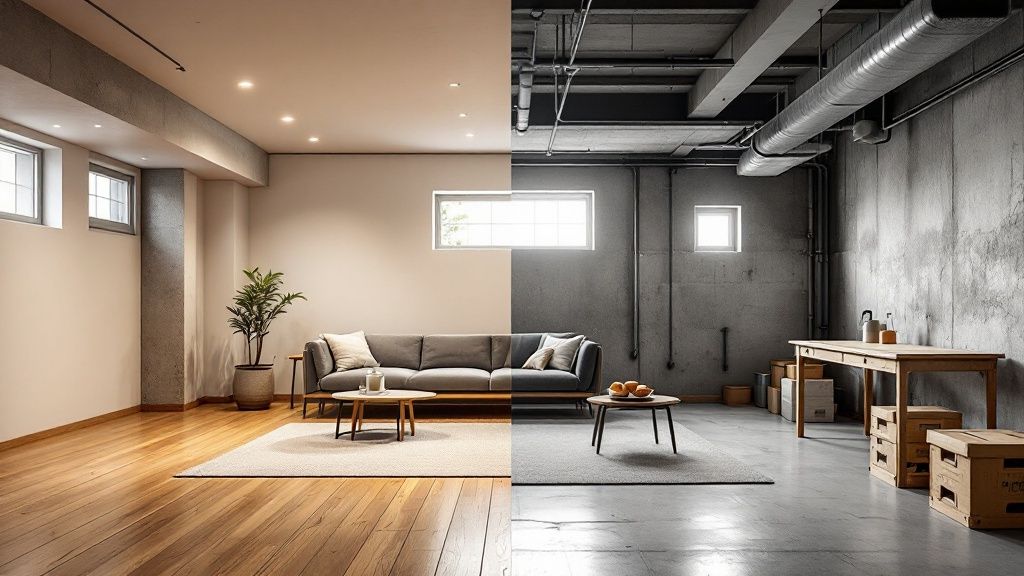When you're weighing the pros and cons of a finished versus an unfinished basement, you're really balancing today's budget against your long-term vision for your home. A finished basement isn't just extra space; it's a fully functional, legally recognized part of your home's total livable square footage. An unfinished basement, on the other hand, is pure utility—a foundational workhorse for storage and your home's mechanical systems.
Finished vs Unfinished Basement Key Differences
Deciding to finish your basement is a big step. It transforms that raw, foundational space into a vibrant extension of your home. A truly "finished" basement has all the key elements in place: proper insulation, drywall, finished ceilings, and safe, up-to-code electrical wiring. In stark contrast, an unfinished basement is a blank canvas of exposed concrete, visible pipes, and open joists, perfect for storage and utilities.
Finishing your basement immediately expands your home's functional footprint. Suddenly you have room for a family den, a quiet home office, an extra bedroom for guests, or even a separate apartment to generate rental income. That new utility doesn't just improve your daily life; it also makes your home far more attractive to future buyers. A well-done basement can add between 10% and 20% to your home's total value, though this depends heavily on the quality of the work and local building codes.
But don't discount the value of an unfinished basement. It offers a different kind of advantage: raw potential and rugged practicality. With everything exposed, accessing plumbing, electrical, and HVAC systems for maintenance or repairs is a breeze. For Utah homeowners, this open, durable space is the perfect spot for a workshop, a home gym, or storing all that outdoor gear without ever worrying about scuffing a finished wall or floor.
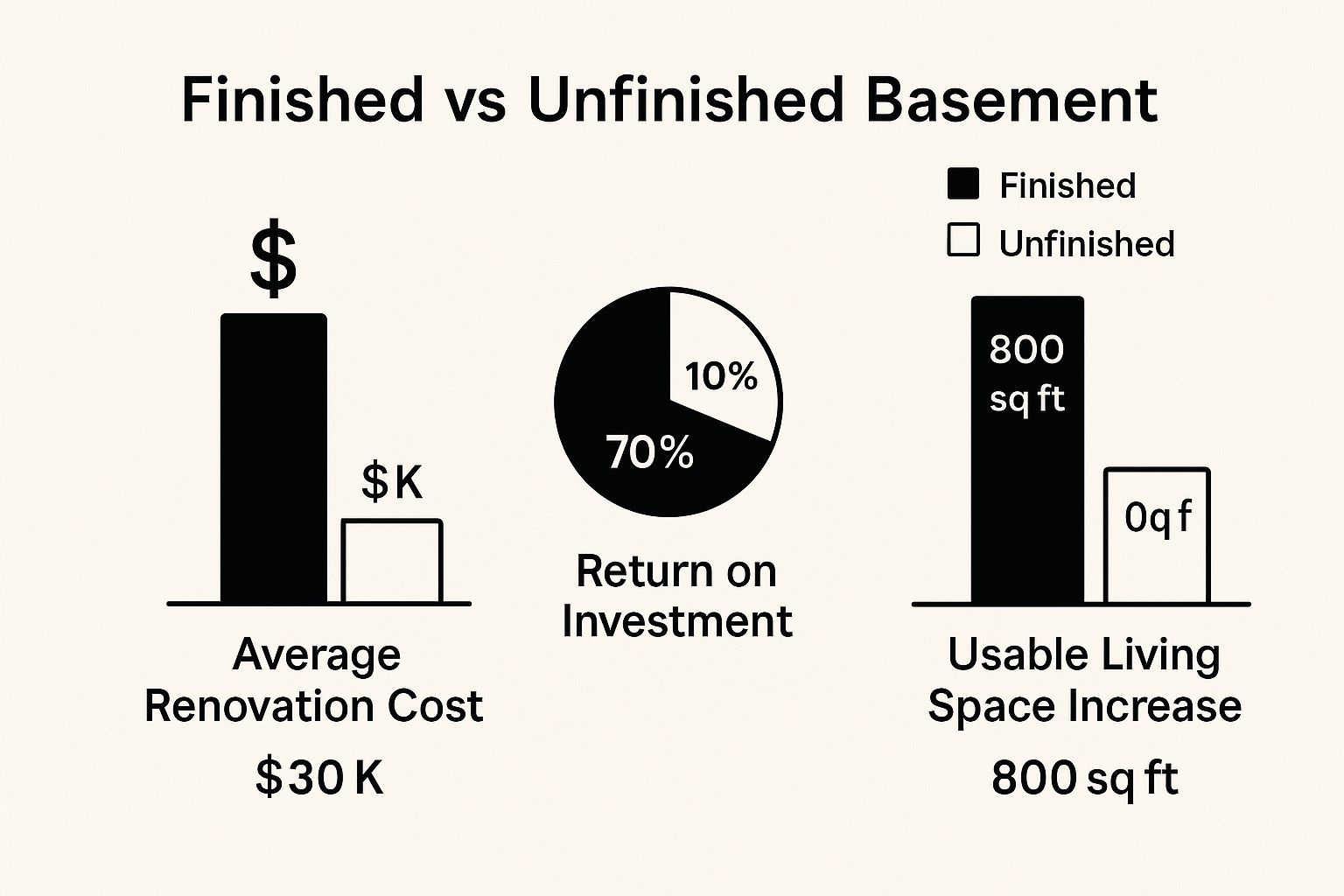
As you can see, the upfront investment for a finished basement is significantly higher, but it pays dividends in both return on investment and the amount of comfortable living space you gain.
Finished vs Unfinished Basement At a Glance
To make the choice clearer, let's break down the core differences in a simple table. This gives you a quick snapshot of how each option stacks up in terms of usability, cost, and impact on your property's value.
| Primary Use | Livable space (bedrooms, family rooms, offices) | Storage, workshop, laundry, utility access |
| Home Value | Significantly increases resale value and equity | Minimal impact on resale value; seen as potential |
| Initial Cost | High investment for construction and finishes | Low to no initial cost beyond the home's price |
| Flooring | Requires finished surfaces like carpet, LVP, or tile | Bare concrete or basic sealing |
| Walls & Ceiling | Drywall, paint, and finished ceilings | Exposed concrete, insulation, and open joists |
| Comfort | Climate-controlled, insulated, and well-lit | Often damp, cold, and poorly lit |
Remember, selecting the right materials is crucial when finishing a basement. The flooring, in particular, has to stand up to the unique challenges of a below-grade environment. For some great ideas, check out our guide on the best basement flooring options to find solutions that are both durable and stylish.
Comparing the Financial Investment and ROI
Let's talk money. For most homeowners, the decision between a finished and unfinished basement comes down to the numbers. It's not just about the upfront price tag, though. We need to look at the total investment, what you'll spend over time, and what you’ll get back in return—especially in Utah’s dynamic housing market.
An unfinished basement is the path of least resistance financially, representing a low initial cost. A finished basement, on the other hand, is a serious home improvement project with a budget to match.
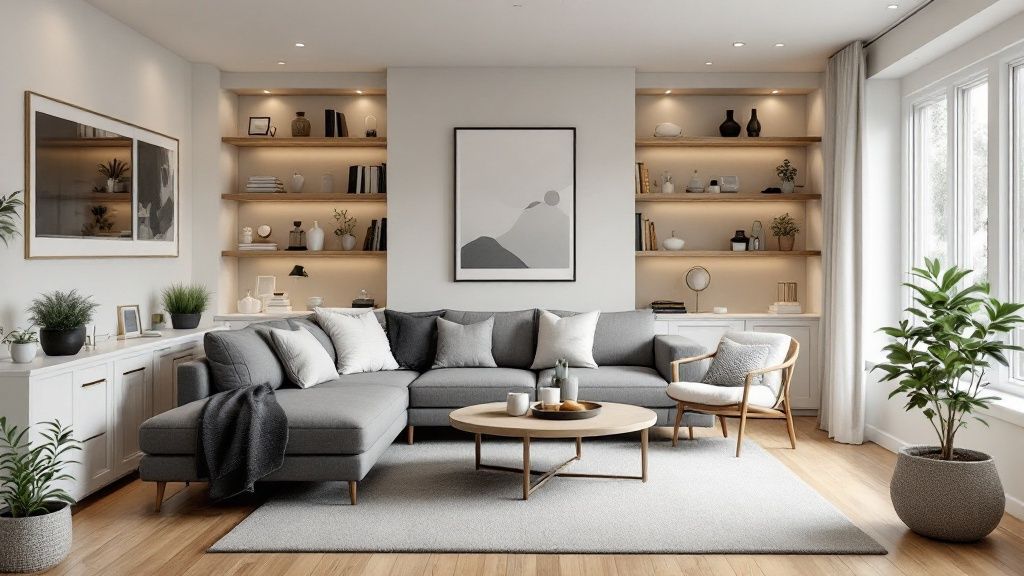
The biggest draw of leaving a basement unfinished is, without a doubt, the minimal cost. Once you've bought the house, there are no immediate, mandatory expenses for construction or materials. Maintenance is simple and cheap—usually just keeping an eye out for moisture and pests. This makes it a no-brainer for homeowners on a tight budget or those who just need raw, functional space for storage.
Breaking Down the Cost of a Finished Basement
Finishing a basement is a full-blown construction project, and the investment reflects that. The cost goes way beyond just putting up some drywall and laying down carpet. For Utah homeowners, several critical expenses add up quickly:
- Permits and Inspections: Your local city or county will require permits to ensure everything is built to code and, most importantly, is safe.
- Egress Windows: This is a big one. Any bedroom you add downstairs legally requires an egress window for fire safety. This often means cutting into your foundation—a necessary and significant expense.
- Framing and Insulation: Creating the framework for walls and properly insulating them is the foundation of a comfortable, energy-efficient living space.
- Electrical and Plumbing: Running new wiring for outlets and lights is a given. If you're adding a bathroom or a kitchenette, plumbing work will add a considerable amount to the final bill.
- Finishes: This is where the personality comes in—flooring, paint, trim, and light fixtures. The costs here can vary dramatically, but they are essential for making the space truly livable.
These pieces combine to form a substantial initial investment. To see a more detailed breakdown, check out our guide on how much a basement remodel costs for a clearer picture of what to expect.
Calculating the Return on Investment
While the upfront cost is steep, a finished basement delivers a powerful return on investment, both in your wallet and your lifestyle. You're immediately adding valuable, livable square footage to your home, which is a primary driver of property value. That new space can make your home significantly more attractive when it's time to sell.
A finished basement is one of the few home renovations that offers a substantial and predictable return. It not only enhances your daily living but also acts as a tangible asset that appreciates with your home's value over time.
National data consistently shows that finishing a basement has a major impact on resale value. On average, a project costing around $32,000 can boost a home's value by about $24,000. That translates to a solid 70% to 75% return on investment. This makes it one of the smartest remodeling projects a homeowner can take on.
Understanding the Hidden and Ongoing Costs
The financial story doesn't end once the construction crew leaves. A finished basement brings ongoing expenses that you don't have with an unfinished one. This table lays out the long-term financial picture.
Cost and ROI Breakdown Finished vs Unfinished Basement
| Initial Investment | $25,000 - $75,000+ | $0 - $2,000 (for basic sealing) |
| Increased Property Taxes | 5% - 10% annual increase | No significant change |
| Monthly Utility Bills | $50 - $150+ higher (HVAC) | Minimal increase |
| Maintenance & Repairs | Moderate (finished surfaces) | Low (structural focus) |
| Return on Investment (ROI) | 70% - 75% of cost recouped | N/A (value is in potential) |
Because you’re adding legal living space, your property’s assessed value goes up, which means your annual property taxes will, too. Plus, heating and cooling a whole new level will naturally increase your monthly utility bills. These recurring costs are crucial to consider when weighing the true financial commitment of a finished vs. unfinished basement.
How Each Basement Type Impacts Your Lifestyle
Forget the spreadsheets and ROI calculators for a moment. The real decision between a finished and an unfinished basement comes down to how you live. It's a choice that shapes your family's daily routines, weekend adventures, and overall comfort in your own home.
A finished basement is an instant upgrade to your living space, designed to fit right into your family's life. This isn't just about adding square footage—it's about creating a purpose-built area for connection and comfort.
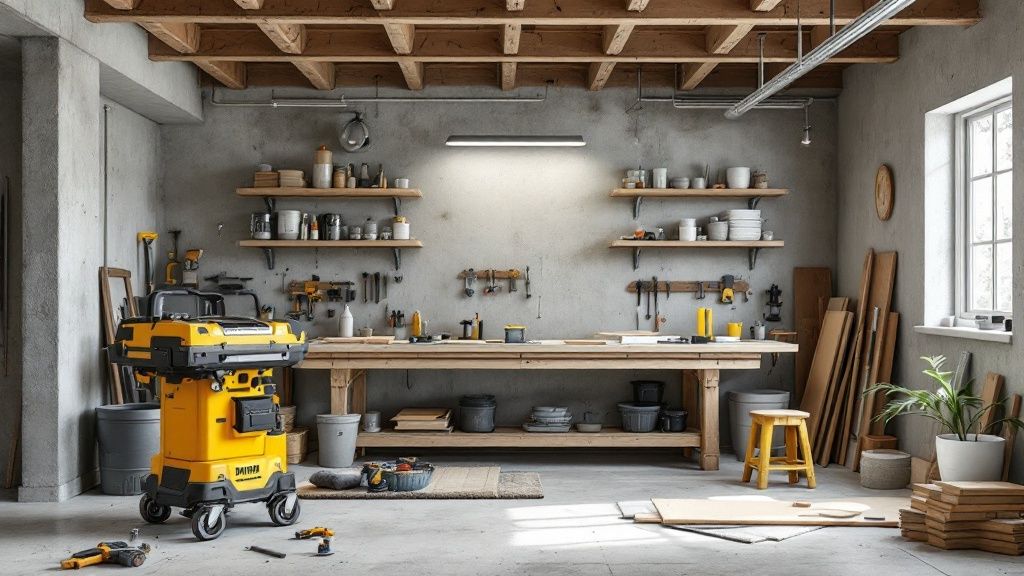
This is where a finished basement really proves its worth: transforming a concrete shell into a warm, inviting part of your home. It quickly becomes the go-to spot for the things that make your life better.
The Finished Basement: An Extension of Your Home
For many Utah families, a finished basement becomes the heart of the home, especially during our long winters. It can be a cozy retreat for movie nights, a dedicated playroom that keeps the upstairs tidy, or a separate space for teens to hang out with their friends.
Here’s how that plays out in the real world:
- The Family Entertainment Hub: Picture a dedicated home theater with plush seating and perfect lighting. It’s the ideal spot for family movie marathons or watching the big game with friends.
- The Multi-Generational Suite: With more families living together, a finished basement can become a legal Accessory Dwelling Unit (ADU). This offers both privacy and independence for aging parents or adult children.
- The Productive Home Office: A quiet, well-lit basement office creates a professional-grade workspace, giving you a clear separation between your job and your home life. We have a whole guide on designing a basement home office to get you started.
A finished basement stops being "the downstairs" and becomes a destination. It’s where memories are made, hobbies are pursued, and your home’s functional capacity is truly maximized.
The Unfinished Basement: A Space of Opportunity
On the flip side, the true value of an unfinished basement is its raw potential and rugged flexibility. This is a space of pure utility, where function wins out over form every time. For homeowners who need durable, practical space without the cost of a full renovation, it's the perfect solution.
Don't mistake an unfinished basement for an empty one; it's a zone of opportunity. It can handle jobs that a carpeted, drywalled room just can't.
For many Utahns with active, hands-on lifestyles, this is a huge plus. The concrete floors and exposed joists are features, not flaws.
Think about these practical uses:
- The Ultimate Gear Room: Store your skis, snowboards, mountain bikes, kayaks, and camping gear without worrying about scuffing walls or staining carpets. The wide-open layout makes it easy to organize and grab what you need.
- The Dedicated Workshop: This is a dream come true for woodworkers, mechanics, and hobbyists. It's a durable environment that can handle messy projects while keeping the noise contained and away from the main living areas.
- The No-Fuss Home Gym: An unfinished basement is the perfect spot for a serious home gym. You can drop heavy weights on the concrete floor, bolt a squat rack directly to the foundation, and just focus on your workout.
In the end, it boils down to one question: Do you need more "living" space or more "doing" space? One offers polished comfort for your family, while the other provides a tough, flexible workhorse ready for any project or adventure. Your family's unique rhythm will point you toward the right answer.
Navigating Utah Building Codes and Design Hurdles
Transforming a basement isn't just about picking out paint colors and flooring. Here in Utah, you have to work with specific building codes and some common structural quirks. Think of these rules less as red tape and more as a roadmap to ensure your project is safe, legal, and built to last. Honestly, skipping this step can jeopardize your family's safety and lead to some costly fixes down the road.
For most of us in northern states like Utah, basements are just part of the package. Builders have to dig the foundation deep to get below the frost line, so adding a basement becomes a practical way to gain a ton of square footage. This reality is a big reason why so many Utah homes have basements just waiting to be finished, which you can learn more about in this article on how climate influences home design.
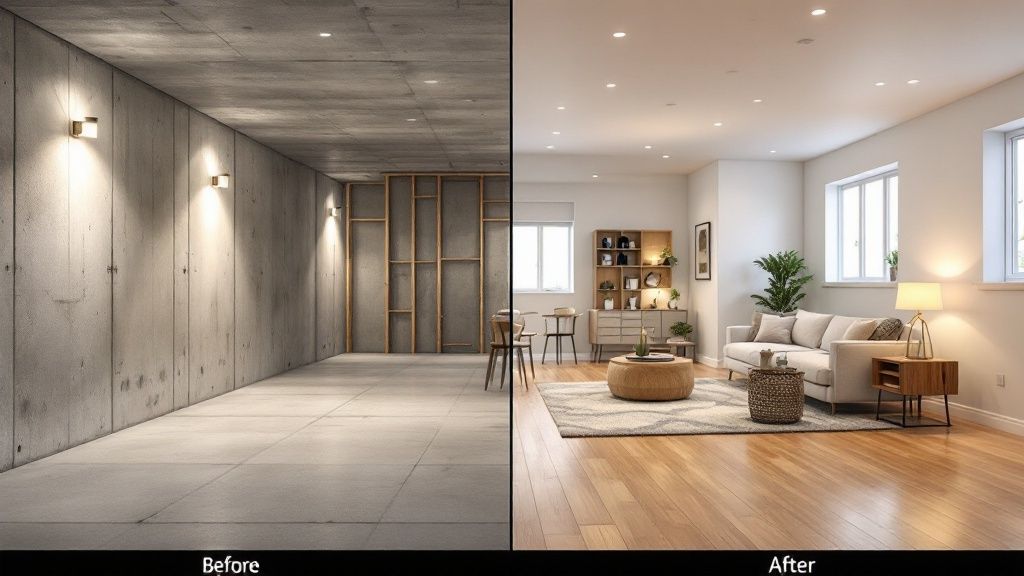
This built-in potential is fantastic, but it comes with a few hurdles you'll need to clear, especially when turning that raw, unfinished space into a genuine living area.
Egress Windows and Safety Codes
Let's talk about one of the biggest, non-negotiable rules for a finished basement in Utah: safety exits. If you're planning to add a bedroom downstairs, the state building code is non-negotiable—it must have an egress window. This isn't your average window. It needs to be big enough and low enough to the floor for someone to climb out easily during a fire.
Putting in an egress window is a major job. It usually means cutting a large opening in your concrete foundation and then digging out an exterior window well. This is absolutely a job for a professional and will be a significant line item in your budget. But it's the one thing that makes your new space legally compliant and, more importantly, safe for your family.
Even if you keep your basement unfinished, knowing about egress requirements is just plain smart. When it's time to sell, a potential buyer will immediately see the lack of an egress point as a big project—and cost—they'll have to take on themselves.
Managing Moisture and Radon Gas
Basements and moisture go hand in hand, but Utah’s climate and soil can create their own unique issues. Before a single 2x4 goes up, you need a rock-solid plan for waterproofing and moisture control. This could involve sealing foundation cracks, making sure your sprinklers and grading are directing water away from the house, or installing a sump pump.
Radon gas is a real and serious concern across Utah. It's invisible, odorless, and a known health hazard. You absolutely must test for radon before you start finishing your basement. If the levels are high, a mitigation system is necessary—and it's so much easier and cheaper to install before the drywall goes up.
Even in an unfinished basement, keeping moisture under control is crucial for preventing mold and protecting whatever you're storing down there. A good coat of concrete sealer on the floors and walls can make the space far healthier and more useful. Proactive moisture management is just a smart investment, no matter how you plan to use the space.
Design Hurdles in Utah Basements
Codes aside, the physical layout of a basement can throw a few curveballs your way. Low ceilings, massive ductwork, and support columns smack in the middle of the room are all part of the territory.
- Low Ceilings: Many older Utah homes have basements with ceilings just a bit shy of today's standard height. You can get creative with recessed lighting to save every inch, or paint the ceiling a light color to make it feel taller. Some people even embrace the look and leave the ceiling joists exposed for an industrial-chic vibe.
- Structural Columns: Those support posts always seem to be right where you want your giant sectional to go. Instead of fighting them, make them part of the design. You could wrap them in wood to look like a craftsman-style column or even build a small bar or shelving unit around them.
- Utility Access: Whether your basement is finished or unfinished, you always need clear access to the furnace, water heater, and main water shut-off. In a finished space, this means designing a dedicated utility room that's easy to get into. An unfinished basement, of course, offers wide-open access by default.
Long-Term Maintenance and Home Value
Once the last nail is hammered in and the dust settles, you start living with your decision. This is where the long-term reality of a finished vs. unfinished basement really shows up—not just in your home's Zillow estimate, but also on your Saturday to-do list. Thinking about these future implications is crucial for making a choice you'll be happy with for years, not just for the first few months.
A finished basement becomes a living, breathing part of your home, and its upkeep reflects that. It needs the same attention as your living room or kitchen, with a few unique challenges thrown in because it's underground.
On the other hand, an unfinished basement requires a more fundamental, bare-bones kind of care. You’re not worried about aesthetics; you’re focused on structural integrity and keeping the space functional.
Upkeep for a Finished Basement
Keeping a finished basement in top shape is all about protecting your investment and ensuring the space remains comfortable and safe. It demands a proactive mindset to stop small issues from turning into wallet-draining disasters.
Your regular maintenance list will probably look something like this:
- Humidity and Climate Control: You'll need to keep a close eye on humidity levels to prevent mold and mildew from taking hold. For most Utah homes, this means running a dehumidifier, especially during spring runoff and summer thunderstorms.
- Sump Pump Servicing: The sump pump is your first line of defense against flooding. It’s not a "set it and forget it" appliance. It needs to be tested every season and professionally serviced once a year to make sure it's ready to kick on when a storm hits.
- Maintaining Finished Surfaces: Just like the rest of your house, the drywall, flooring, and paint down there will need regular cleaning and touch-ups. Life happens—scuffs, spills, and general wear and tear are part of the deal.
- Higher Repair Costs: This is the big one. If water does manage to get in, the repair bill for a finished space is exponentially higher. You're not just drying a concrete slab; you're tearing out soggy drywall, replacing ruined carpet or laminate, and potentially calling in mold remediation experts.
Caring for an Unfinished Basement
An unfinished basement’s maintenance routine is far simpler and cheaper. The focus is squarely on the foundational health of your home, not on cosmetics.
Your key tasks are pretty straightforward:
- Moisture and Leak Checks: Your main job is to periodically walk the perimeter and inspect the foundation walls for new cracks or any signs of moisture. A little bit of sealant on a small crack now can save you from a massive headache later.
- Pest Control: Spiders and other critters love unfinished spaces. A little preventative pest control can go a long way in keeping them out of your house entirely.
- Structural Health: One of the unsung benefits here is visibility. With everything exposed—pipes, wiring, foundation—it's much easier to spot potential problems before they get hidden behind a wall and become major, surprising repairs.
The real difference in long-term ownership comes down to this: With a finished basement, you’re maintaining a living space. With an unfinished one, you’re maintaining a foundational utility area. One protects your comfort and aesthetic investment; the other protects the raw structure of your home.
Revisiting Long-Term Home Value
When you look down the road, both types of basements add to your home's value, but they do it in completely different ways.
A finished basement adds tangible, immediate value. It gives you legal, livable square footage that goes up in value right alongside the rest of your house. As the Utah housing market continues to climb, the value of that extra bedroom, bathroom, or family room grows with it, often compounding your initial ROI.
An unfinished basement offers something else entirely: potential value. For a lot of buyers, a clean, dry, unfinished basement is a blank canvas. This is a huge selling point for anyone who loves a good DIY project or a family that wants to build out a space exactly to their own taste, without needing to demo your 90s-era wet bar first. That untapped potential can be a very attractive feature in a hot market, letting buyers dream up their own perfect space.
Making the Right Choice for Your Home
Deciding between a finished and an unfinished basement isn't just about ticking off pros and cons. The best choice is deeply personal—it’s about your family's needs right now, your financial reality, and what you see for your home's future.
Let’s reframe the question to get to the heart of it: are you after an immediate lifestyle upgrade or long-term flexibility? Answering that one question will bring a lot of clarity to your decision.
For homeowners feeling the squeeze or looking to generate income, a finished basement is the obvious path forward. If your family is growing, turning that downstairs space into a playroom and an extra bedroom isn't a luxury; it's a practical solution that makes daily life better. Likewise, if you're dreaming of a legal rental unit to help offset the mortgage, a fully finished, code-compliant space is the only way to go.
An unfinished basement, on the other hand, is all about practicality and potential. It’s the sensible choice if you're on a tighter budget and desperately need good, functional storage more than you need another living room. For the avid DIYer who sees a future workshop, those bare concrete floors and exposed joists are perfect. It keeps your options open, giving you a blank canvas to work with when your budget and vision finally line up.
Your Decision-Making Checklist
To bring it all home, let's get practical. Run through these questions and your answers should point you in the right direction for your specific situation as a Utah homeowner.
- Budget: Can you comfortably afford a full renovation right now, including a 10-15% buffer for those inevitable surprises?
- Timeline: Do you need more living space in the next year, or is this a dream for five or ten years from now?
- Primary Use: Is this space going to be for people (like a family room or bedroom) or for stuff (like storage, a home gym, or a workshop)?
- DIY Spirit: Are you itching to tackle a big project yourself down the road, or do you just want a turnkey space you can use immediately?
- Long-Term Plans: Do you see yourself in this home for more than five years? That timeframe makes the upfront investment in finishing the basement much easier to justify.
- Resale Strategy: When you eventually sell, who is your ideal buyer? Someone who wants a move-in-ready home, or someone who wants the potential to make it their own?
There’s no single "right" answer in the finished vs. unfinished basement debate. The best choice is the one that solves your immediate problems without creating a financial headache, aligning perfectly with how you and your family actually want to live.
By thinking through these scenarios and being honest with your answers, you can confidently pick the basement solution that serves you best—not just today, but for years to come.
Have Questions? We Have Answers
When you're weighing the pros and cons of finishing your basement, a lot of specific questions pop up. It’s a big decision, especially for Utah homeowners. Here are some straightforward answers to the questions we hear most often.
Will Finishing My Basement Automatically Raise My Property Taxes?
Almost certainly, yes. When you finish a basement (with the proper permits, of course), you're officially converting storage space into what's called "gross living area." The county assessor takes note of this increased value, and your property tax bill will reflect it.
The best move? Call your local Utah county assessor's office before you start. They can often give you a ballpark idea of what to expect, so there are no surprises later.
What's the Absolute First Thing I Should Do Before Starting?
Before you even think about framing a single wall, you have to make sure your basement is bone dry. Seriously, this is the one step you can't skip. Basements are naturally prone to moisture, and tackling any potential water issues now will save you a world of heartache.
Proper waterproofing is non-negotiable and usually involves:
- Sealing every last crack in the foundation walls and floor.
- Checking that the ground outside slopes away from your house, not toward it.
- Making sure you have a reliable sump pump and drainage system that’s in good working order.
Ignoring moisture problems is like building a house on sand. You're just setting up your beautiful new investment to be ruined by mold, mildew, or a flood.
Can I Set Up a Home Gym in My Unfinished Basement?
You bet. An unfinished basement is practically perfect for a home gym. The concrete floor is a huge plus—you can drop weights without worrying about cracking tiles or denting expensive flooring.
The wide-open space gives you total freedom to arrange your squat rack, treadmill, and benches however you like. To make it more comfortable, throw down some rubber gym mats, install bright LED lighting, and make sure you have some airflow.
How Big of a Deal Is Radon Gas in a Utah Basement?
It's a very big deal. Radon is a naturally occurring radioactive gas that's prevalent across Utah, and it can seep right into your home through the foundation. It's a serious health hazard that you need to address head-on.
Before you start your project, you must test for radon. If the levels come back high, you'll need to install a radon mitigation system. It's far easier and cheaper to put this system in before the drywall and ceilings go up, ensuring the air in your new living space is safe for your family.
Ready to turn that concrete box downstairs into a space your family will love? The team at Northpoint Construction knows exactly how to get it done right, from making sure it's waterproof to adding those final, perfect touches. Contact us today to talk about your ideas and get a free estimate.

